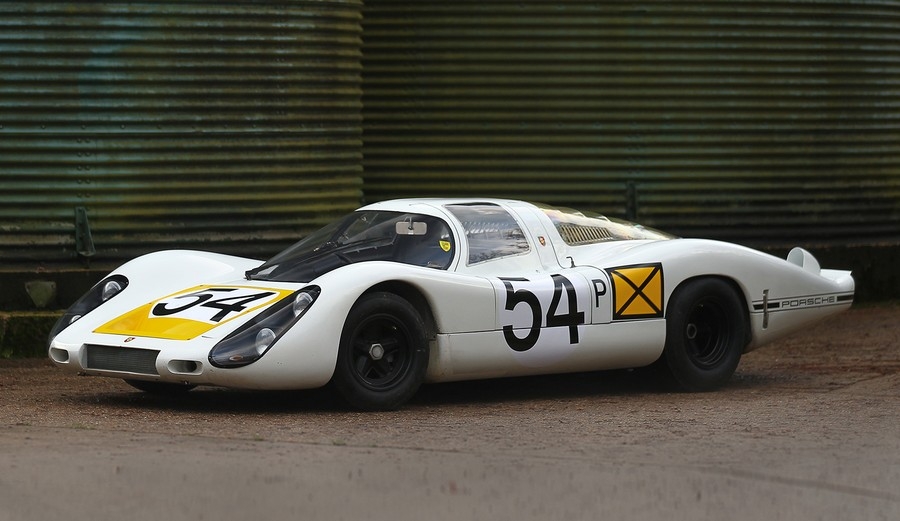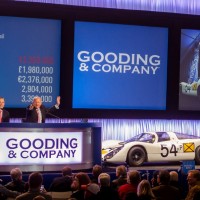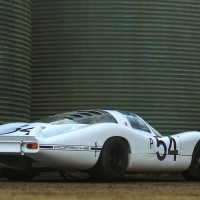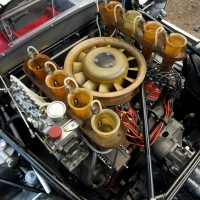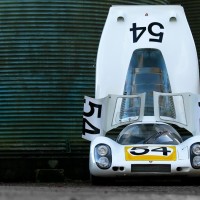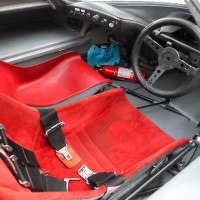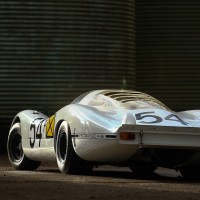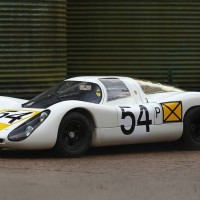SCM Analysis
Detailing
| Number Produced: | Eight (two left in LH form) |
| Original List Price: | N/A |
| Chassis Number Location: | Tag on tube in engine bay |
| Engine Number Location: | Unknown |
| Club Info: | Porsche Club of America |
| Website: | http://www.pca.org |
| Investment Grade: | A |
This car, Lot 66, sold for $3,630,000 at Gooding & Company’s Amelia Island, FL, auction on March 7, 2014.
If you’ve got high aspirations, there’s nothing like being the little kid on the block to make you obsessive. Although no weakling, Porsche had spent its life in the welterweight class, watching the big boys get the glory and the podium finishes in all the serious events. It was frustrating; they could get so close, but in the end there was no substitute for cubic inches, and the biggest engine Porsche had was its Type 771 2.2-liter flat 8. But just maybe, if they could get the weight and drag coefficient down far enough, they could challenge for an overall victory on a really long, fast course — such as Le Mans. Once the dreaming started, things started to fall into place.
From frustration to domination
Making sense of how the 907 fits into things requires an overview of Porsche’s racing models of the 1960s. For a more detailed look, I highly recommend Karl Ludvigsen’s superb book Porsche — Excellence Was Expected, from which I obtained most of the history. At the beginning of the decade, Porsche was racing the RS 60 and RS 61 models; alloy-bodied, tube-frame racers that had evolved from the 550 Spyders of the 1950s and were at the end of their competitiveness.
To replace them, Porsche started with a mostly clean sheet of paper to create the 904, which utilized a folded steel chassis with a fiberglass body and new suspension. The 4-cam 2-liter engine and transmission from the earlier cars was retained because the new 2-liter six was not considered ready for competition. It was conceived as a dual-purpose car, suitable for both GT and racing use, with the serious racing versions getting the new six or the GP-based 711 flat eight.
The problem with a dual-personality approach was that it was a bit heavy, particularly for the European Hillclimb Championship that Porsche sort of assumed it owned. So when Ferrari’s 206 Dino started winning the series, it was time for a radical departure.
In a frantic several months during the late summer of 1965, the experimental department created a one-off hillclimb special that became known as the “Ollon-Villars Spyder.” Although technically still a 904 (chassis 906/010), it had a tubular frame, new suspension, 13-inch wheels (along with hubs, brakes and uprights) bought from the Lotus F1 team, a very light, open body, and the 771 flat eight engine. The car arrived too late to save the hillclimb championship, but it re-established the idea of a tube-framed pure racer in the Porsche mentality.
The 904 was quickly replaced by the 906, which used the now-well-developed Carrera 6 engine in the tubular frame developed for the hillclimb car but retaining the suspension, brakes, and 15-inch wheels from the 904.
The 906 proved to be a very formidable and successful competitor, but this was a time of very fast evolution, so Porsche’s next step was to develop their own version of the Lotus bits used on the Ollon-Villars Spyder and adapt them to the 906 chassis. The 13-inch wheels and developing tire technology allowed the new car to be substantially lower and have a much lower drag coefficient, with the body tightly wrapped around the components. It still used the 906 engine and transmission, but it was much faster. Porsche named it the 910, which is strangely out of sequence: The best guess is that the number came from the Ollon-Villars Spyder it mimicked (chassis 010).
With the 910, Porsche had gotten itself in an extremely frustrating position. They owned the 2-liter class and were almost — but not quite — fast enough to aspire to overall wins. Dreams of glory and overall wins had started to stir – it was time to double down and go for it. Enter the 907.
The start of something fast
The 907 was conceived and built as a way to win the 1967 Le Mans race. It was fundamentally a lightweight 910 built to carry the 2.2-liter 771 flat eight wrapped in the absolutely lowest drag coupe body that it was possible to design and fit a driver inside. Unfortunately, the eight wasn’t yet reliable enough for a 24-hour race, so the 1967 Le Mans cars used the 2-liter six. The first examples achieved spectacularly low drag, but at the expense of stability: At the Le Mans test weekend, on the Mulsanne Straight, none of the 907 drivers dared take their hands off the wheel long enough to shift into 5th gear, so they only went 148 mph. Though drivability was improved substantially by the actual race, there was only so much to be done with a 2-liter car against 4.4-liter Ferraris and 7-liter GT40s. Porsche was very pleased to bring home a 5th overall and the Index of Performance award, but they weren’t there yet.
Shortly after the 1967 Le Mans race, the FIA did Porsche a huge favor: They changed the rules. Beginning in 1968, the championship would be limited to 3-liter cars. Now, instead of Porsche having to play by big-car rules, the big boys were going to have to play in Porsche’s specialty.
Porsche immediately began design work on a new 3-liter racing eight and the adaptations required to put that engine into a 907, which would be called the 908. Simultaneously, the engineers managed to get the 2.2-liter 771 engine reliable enough for endurance racing, which was good because the new 908 engine proved to be a problem child and would take over a year to develop. When the 1968 season dawned, the racing world belonged to Porsche’s 907 LH with the 2.2-liter 771 engine — today’s subject car — as it led a Porsche 1-2-3 sweep at Daytona. Porsche had finally reached the pinnacle.
The market speaks
All of which brings us back to our analysis of this car as an icon, a racing toy and a collector piece.
As an icon, this car is a given: Porsche, now the uncontested champion of endurance racing, first stood atop the podium with this car — this is the point where frustration ended and domination began.
Porschephiles around the world genuflect before it, but as a racing toy, this car is problematic. Although successful, the longtail 907s were never much fun to drive, as the aerodynamics made them difficult at speed and claustrophobic to sit in. And then there is the engine. The Grand Prix-based 771 engine was insanely complicated. The factory needed 220 man-hours (5.5 man-weeks) for a skilled mechanic to build one, whereas the Carrera 6 engine took just 16. They made good horsepower and proved reliable, particularly for shorter races, but you never, ever, want to have to work on one. As a result, this is a car that may be run up the hill at Goodwood or do demo laps at Rennsport Reunions, but nobody is ever going to actually race it.
As a collector piece, the question is setting a value, and comps are tough to find. The 906, 910 and 908 models are far more drivable and competitive, but generally less collectible: 906 cars are a bit over a $1 million, 910 cars a bit over $1.5 million, and 908 cars somewhere above that. 917s are wildly valuable, but they are really a different category of Porsche.
In the end, I think we need to trust the market. This car sold for the lower end of its estimate, which suggests that it was the minimum the seller would accept — and all the parties here are highly knowledgeable. This was a fair market transaction: well bought and sold. ♦
(Introductory description courtesy of Gooding & Company.)
